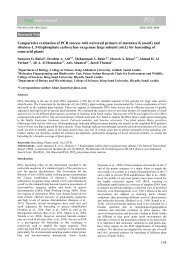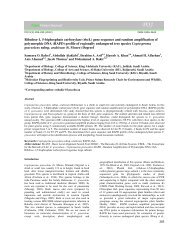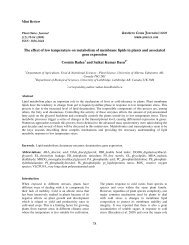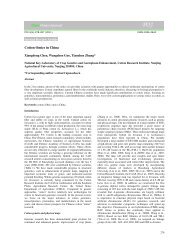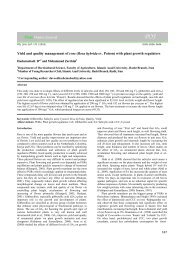Potential of Molecular Markers in Plant Biotechnology - ResearchGate
Potential of Molecular Markers in Plant Biotechnology - ResearchGate
Potential of Molecular Markers in Plant Biotechnology - ResearchGate
You also want an ePaper? Increase the reach of your titles
YUMPU automatically turns print PDFs into web optimized ePapers that Google loves.
Review article<br />
Disadvantages: Disadvantages <strong>in</strong>clude the need for<br />
purified, high molecular weight DNA, the dom<strong>in</strong>ance<br />
<strong>of</strong> alleles, and the possible non-homology <strong>of</strong><br />
comigrat<strong>in</strong>g fragments belong<strong>in</strong>g to different loci. In<br />
addition, due to the high number and different<br />
<strong>in</strong>tensity <strong>of</strong> bands per primer comb<strong>in</strong>ation, there is the<br />
need to adopt certa<strong>in</strong> strict but subjectively<br />
determ<strong>in</strong>ed criteria for acceptance <strong>of</strong> bands <strong>in</strong> the<br />
analysis. Special attention should be paid to the fact<br />
that AFLP bands are not always <strong>in</strong>dependent. For<br />
example, <strong>in</strong> case <strong>of</strong> an <strong>in</strong>sertion between two<br />
restriction sites the amplified DNA fragment results<br />
<strong>in</strong> <strong>in</strong>creased band size. This will be <strong>in</strong>terpreted as the<br />
loss <strong>of</strong> a small band and at the same time as the ga<strong>in</strong><br />
<strong>of</strong> a larger band. This is important for the analysis <strong>of</strong><br />
genetic relatedness, because it would enhance the<br />
weight <strong>of</strong> non-<strong>in</strong>dependent bands compared to the<br />
other bands. However, the major disadvantage <strong>of</strong><br />
AFLP markers is that these are dom<strong>in</strong>ant markers.<br />
Applications: AFLPs can be applied <strong>in</strong> studies<br />
<strong>in</strong>volv<strong>in</strong>g genetic identity, parentage and<br />
identification <strong>of</strong> clones and cultivars, and<br />
phylogenetic studies <strong>of</strong> closely related species<br />
because <strong>of</strong> the highly <strong>in</strong>formative f<strong>in</strong>gerpr<strong>in</strong>t<strong>in</strong>g<br />
pr<strong>of</strong>iles generally obta<strong>in</strong>ed. Their high genomic<br />
abundance and generally random distribution<br />
throughout the genome make AFLPs a widely valued<br />
technology for gene mapp<strong>in</strong>g studies (Vos et al.<br />
1995). AFLP markers have successfully been used for<br />
analyz<strong>in</strong>g genetic diversity <strong>in</strong> some other plant<br />
species such as peanut (Herselman, 2003), soybean<br />
(Ude et al. 2003), and maize (Lübberstedt et al.<br />
2000). This technique is useful for breeders to<br />
accelerate plant improvement for a variety <strong>of</strong> criteria,<br />
by us<strong>in</strong>g molecular genetics maps to undertake<br />
marker-assisted selection and positional clon<strong>in</strong>g for<br />
special characters. <strong>Molecular</strong> markers are more<br />
reliable for genetic studies than morphological<br />
characteristics because the environment does not<br />
affect them. SAMPL is considered more applicable to<br />
<strong>in</strong>traspecific than to <strong>in</strong>terspecific studies due to<br />
frequent null alleles. AFLP markers are useful <strong>in</strong><br />
genetic studies, such as biodiversity evaluation,<br />
analysis <strong>of</strong> germplasm collections, genotyp<strong>in</strong>g <strong>of</strong><br />
<strong>in</strong>dividuals and genetic distance analyses. The<br />
availability <strong>of</strong> many different restriction enzymes and<br />
correspond<strong>in</strong>g primer comb<strong>in</strong>ations provides a great<br />
deal <strong>of</strong> flexibility, enabl<strong>in</strong>g the direct manipulation <strong>of</strong><br />
AFLP fragment generation for def<strong>in</strong>ed applications<br />
(e.g. polymorphism screen<strong>in</strong>g, QTL analysis, genetic<br />
mapp<strong>in</strong>g).<br />
M<strong>in</strong>isatellites, Variable Number <strong>of</strong> Tandem Repeats<br />
(VNTR)<br />
Introduction: The term m<strong>in</strong>isatellites was <strong>in</strong>troduced<br />
by Jeffrey et al. (1985). These loci conta<strong>in</strong> tandem<br />
repeats that vary <strong>in</strong> the number <strong>of</strong> repeat units<br />
between genotypes and are referred to as variable<br />
number <strong>of</strong> tandem repeats (VNTRs) (i.e. a s<strong>in</strong>gle<br />
locus that conta<strong>in</strong>s variable number <strong>of</strong> tandem repeats<br />
between <strong>in</strong>dividuals) or hypervariable regions<br />
(HVRs) (i.e. numerous loci conta<strong>in</strong><strong>in</strong>g tandem repeats<br />
with<strong>in</strong> a genome generat<strong>in</strong>g high levels <strong>of</strong><br />
polymorphism between <strong>in</strong>dividuals). M<strong>in</strong>isatellites<br />
are a conceptually very different class <strong>of</strong> marker.<br />
They consist <strong>of</strong> chromosomal regions conta<strong>in</strong><strong>in</strong>g<br />
tandem repeat units <strong>of</strong> a 10–50 base motif, flanked by<br />
conserved DNA restriction sites. A m<strong>in</strong>isatellite<br />
pr<strong>of</strong>ile consist<strong>in</strong>g <strong>of</strong> many bands, usually with<strong>in</strong> a 4–<br />
20 kb size range, is generated by us<strong>in</strong>g common<br />
multilocus probes that are able to hybridize to<br />
m<strong>in</strong>isatellite sequences <strong>in</strong> different species. Locus<br />
specific probes can be developed by molecular<br />
clon<strong>in</strong>g <strong>of</strong> DNA restriction fragments, subsequent<br />
screen<strong>in</strong>g with a multilocus m<strong>in</strong>isatellite probe and<br />
isolation <strong>of</strong> specific fragments. Variation <strong>in</strong> the<br />
number <strong>of</strong> repeat units, due to unequal cross<strong>in</strong>g over<br />
or gene conversion, is considered to be the ma<strong>in</strong><br />
cause <strong>of</strong> length polymorphisms. Due to the high<br />
mutation rate <strong>of</strong> m<strong>in</strong>isatellites, the level <strong>of</strong><br />
polymorphism is substantial, generally result<strong>in</strong>g <strong>in</strong><br />
unique multilocus pr<strong>of</strong>iles for different <strong>in</strong>dividuals<br />
with<strong>in</strong> a population.<br />
Advantages: The ma<strong>in</strong> advantages <strong>of</strong> m<strong>in</strong>isatellites<br />
are their high level <strong>of</strong> polymorphism and high<br />
reproducibility.<br />
Disadvantages: Disadvantages <strong>of</strong> m<strong>in</strong>isatellites are<br />
similar to RFLPs due to the high similarity <strong>in</strong><br />
methodological procedures. If multilocus probes are<br />
used, highly <strong>in</strong>formative pr<strong>of</strong>iles are generally<br />
observed due to the generation <strong>of</strong> many <strong>in</strong>formative<br />
bands per reaction. In that case, band pr<strong>of</strong>iles can not<br />
be <strong>in</strong>terpreted <strong>in</strong> terms <strong>of</strong> loci and alleles and similar<br />
sized fragments may be non-homologous. In addition,<br />
the random distribution <strong>of</strong> m<strong>in</strong>isatellites across the<br />
genome has been questioned (Schlötterer 2004).<br />
147



